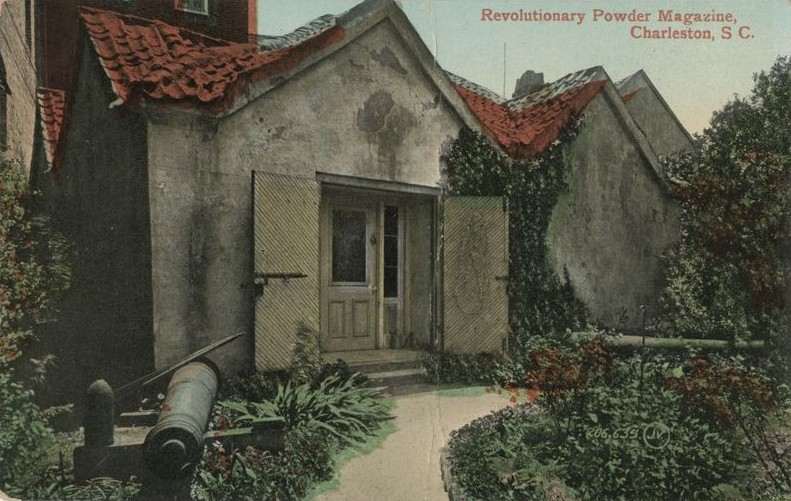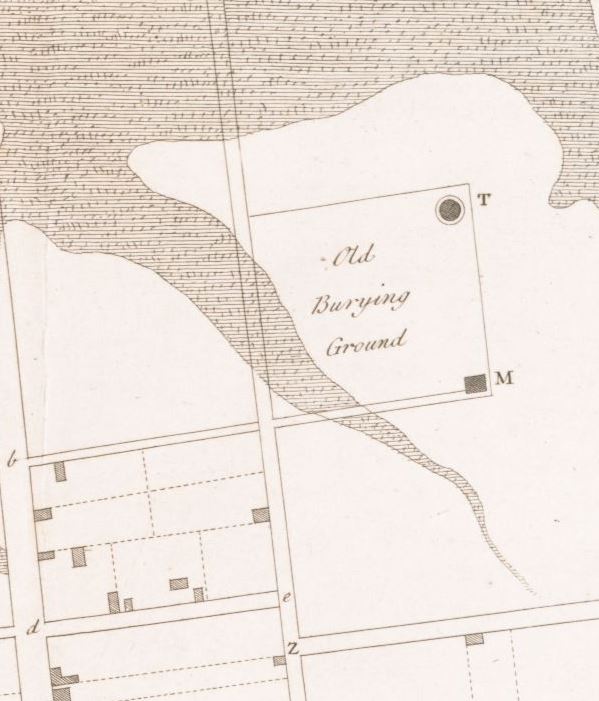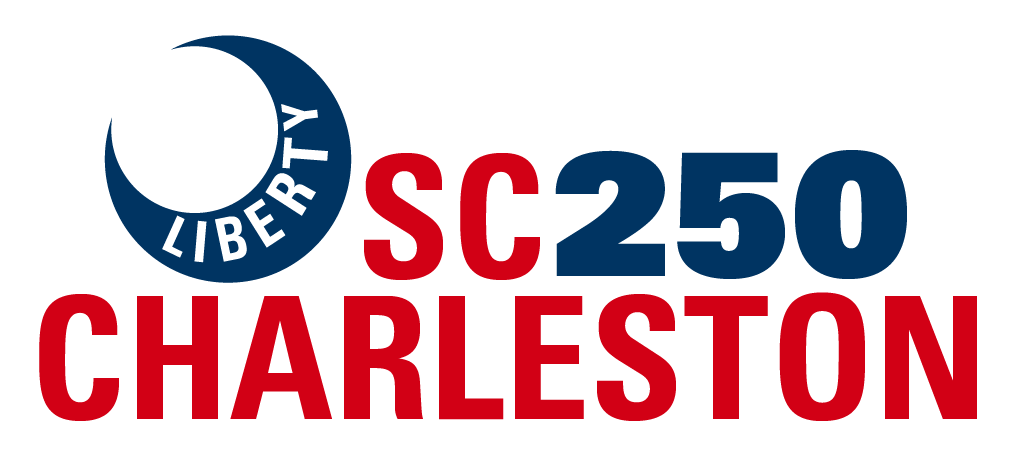The safe and convenient storage of gunpowder was a continual effort during the colonial period, made more challenging by Charleston’s geography and climate. Oversight of the powder necessitated a series of magazine repairs and new construction projects over several decades.
By Brett Bennett
During the 18th century, little was more important to the defense of a community than the ready availability of arms and the gunpowder to make them effective. However, access and storage were a near-constant debate, particularly specific to gunpowder. The powder was precious and must be kept dry – not easy in the sub-tropical climate of the Lowcountry – but also a safety challenge. Ideally, stores of gunpowder would be nearby but not so close to population centers or areas frequently traveled to be major fire or explosion risks.
Old Powder Magazine
Charles Towne’s earliest magazine was located on Cumberland Street and has been known during the modern era as the Powder Magazine Museum. Constructed in 1713, it was soon found that the building was “not to be well and sufficiently covered to preserve the powder therein lodged from any storms of rain which may happen, to the great hazard of endangering the said powder.” Thus, the magazine was of continuous concern for elected officials, and correspondingly, its design and the materials from which it was constructed were updated and frequently repaired.


New Magazine at Old Burying Ground
By 1737, another magazine was constructed at what was then the edge of the city on a portion of the “Old Burying Ground” near the Ashley River. However, within less than two years it was found to be in such poor condition that a committee of the Commons House of Assembly recommended that it be torn down and rebuilt and the old “Public Magazine” on Cumberland Street be repaired and improved with a new floor of cypress or pine, board lining its walls, and stronger window shutters. In addition, the magazine was to be placed under watch every night by “Centrys” who were to be relieved every two hours. The Public Magazine continued its service until more than 50 Merchants, Traders and other inhabitants of Charles Town petitioned the Council, “shewing that they [were] in danger from the Incommodious Situation of the Powder Magazine being so near to the principal Places of Divine Worship, and that several of the Petitioners Traders, have as well as the Publick, suffered damage in their powder, lodged in the said Magazine proceeding from dampness, occasioned by some defect as they imagine in the building of the said Magazine.”[i] After receiving similar follow-on petitions and hearing more protests over the course of twelve months, the Council eventually closed the magazine in 1748, only for it to be used again during the Revolutionary War in the months leading to the Siege of Charleston.
In 1745, the Commons House of Assembly returned to the deficiencies of the magazine near the Old Burying Ground and “Resolved, that the sum of one thousand and five hundred pounds be inserted in the Estimate of the Public Debt… toward the building of a new Magazine” at the same location.[ii] Not long after Governor Glen briefly described the magazine as being “…Bombproof in which there is generally belonging to the Public, and to private persons, near Fifty thousand weight of Powder.”[iii]

After more than twenty years, a committee appointed to audit the Powder Receiver’s accounts found that “the Magazine [was] so crowded on every Shelf, and the whole floor covered, that it would require a whole day” to complete an inventory of the supply.[iv] In fact, the magazine had become so full that its keeper was no longer able to accept private stores of gunpowder from merchants and individuals. Correspondingly, there was an increased safety concern with gunpowder being held randomly in shops and homes among the city’s inhabitants. In December of 1769, the committee then recommended to the House Assembly “the building of another more convenient Magazine or Store House, for Gun Powder which may be made and kept as the Grand Repository for public use.”[v] The committee further reported two available sites for storage, one on a plantation owned by Mr. William Glen on Wappoo Creek and another near Fort Johnson. The relocation of gun powder to the new locations was clearly a temporary solution since the committee’s chairman, Colonel Henry Laurens reported in January “that Hobcaw point is a proper place for building an additional Magazine, capable of containing Sixty thousand Pounds weight of Gun Powder.” A Bill was introduced to the House and amended to include abolishing the Powder Magazine in Charles Town and building another on “Charlestown Neck.”[vi]

Powder Magazines at Hobcaw Point and Charleston Neck
On April 7, 1770, an Act was ratified to implement the committee’s recommendations:
That the Honorable Rawlins Lowndes, John Rutledge, Henry Laurens, Benjamin Dart, David Oliphant, John Poaug, and Miles Brewton, Esquires, be and they are hereby appointed Commissioners for purchasing a piece of ground at Hobcaw Point, and another on Charleston Neck, not exceeding four miles distance from the said town, sufficient for building a powder Magazine at each of the said places capable of containing forty thousand weight if gun powder each, and enclosing the same with a substantial brick wall; and that the said Commissioners shall, as soon as may be, contract and agree with the owners for the said land for the same, and with some proper person or persons for building and enclosing the said Magazines and causing the same to be done… That the Magazines at Hobcaw Point and Charleston Neck shall be under the care of deputy powder receivers, to be appointed for each of the said magazines by the powder receiver for the time being…; and that the said deputy powder receivers shall reside at or near the magazine for which they are respectively appointed.[vii]
Soon after the Act’s ratification, William Davis “surveyed and laid out a piece and parcel of Land containing 10 acres the property of Clement Lempriere at Hobcaw Point, butting and bounding to the North and West partly on Marsh and a Creek out of Wando River…”[viii]

Similarly, a site on Charleston Neck was surveyed by Peter Horlbeck for the same purpose. The parcel consisted of “Three Acres and three Quarters being the property of Margaret Elliot Butting and Bounding to the East and North partly on a Bold Creek out of the Cooper River…”[ix]

By 1772, both new powder magazines had been completed, and the Commons House ordered that guards be employed as safety measures and “to pay the expence of six Men to be guard at the Magazine on Charles Town Neck, and also six Men to guard at the Magazine at Hobcaw Point.” Captain Robert Cochran was named the Deputy Powder Receiver for the site at Charles Town Neck and Mr. Charles Prince for the same position at the Hobcaw Point Magazine.[x]
As chronicled earlier, both magazines were broken open on April 21, 1775 and completely emptied of their powder. About the magazine on Charles Town Neck, Captain Cochran reported that “all the Gun Powder, about 500 lb. Weight, was carried away the preceding night, by persons unknown.” The report of Mr. Prince, Deputy Receiver of the Hobcaw Powder Magazine, was nearly identical, stating that the building was “…broken open on the 21st Instant and One thousand and twenty five pounds of Gun Powder, being all that was in the Magazine, was carried away.”[xi]

Aftermath
During the American Revolution, all of the magazines became even more important assets and were used to their fullest. However, after the war, citizens’ concerns over safety surfaced again, particularly for magazines that were closest to the area’s inhabitants. According to the Powder Receiver, A.A. Muller, about 1783, elected officials ordered “that the most part of the powder shall be kept at the Shipyard, and only the smallest Necessary part in Town Magazine, in order to discharge the City from danger thereof.” In 1788, Muller went on to report and propose to the Governor that the magazine on the Charleston Neck at the shipyard be repaired and maintained through funds generated from the “Sales of the magazines & Lands at Hobcaw & Dorchester” and until another magazine could be constructed “about a mile from the Citty.”[xii] This area of the Charleston Neck would be used for gunpowder and arms storage for many years afterward.
As for the magazine at Hobcaw Point, it fell into decline and by 1836, neighboring property owners led by Paul Remley petitioned the South Carolina House of Representatives to sell the property with the “proceeds of sale given to the School of the Parish or such other disposition made thereof as will relieve your Petitioner and his Brother Parishioners…” The chief complaint was that “from its locality it has become the resort of many disorderly persons from the City who affect a landing at the said Magazine and subject the property of your Petitioner as well as the rest of the Parishioners to depredation…”[xiii]
Lastly, although modest amounts of gunpowder were stored at the Old Magazine as late as 1820, the structure was re-purposed and, for examples, evolved to become a place for wine storage by Dr. Gabriel Manigault and location for a printing press.[xiv] In 1902 the property was acquired by the National Society of The Colonial Dames of America in the State of South Carolina and continues under their care.
Leading Sources
- “Public Powder Magazines at Charleston” by Nora M. Davis; Year Book, City of Charleston, 1942.
- “The Rebellion of South Carolina: April 21st, 1775” by Nic Butler; Charleston Time Machine, May 4, 2018.
- Journal of the Commons House of Assembly
- “The Charleston Gunpowder Plot of 1731, Part 1” by Nic Butler; Charleston Time Machine, June 21, 2024.
- “The Charleston Gunpowder Plot of 1731, Part 2” by Nic Butler; Charleston Time Machine, June 28, 2024.
[i] Council Journal, January 19, 1743.
[ii] Journal of the Commons House of Assembly, May 21, 1745.
[iii] Public Records of South Carolina, Volume 23, page 371.
[iv] Journal of the Commons House of Assembly, August 10, 1769.
[v] Journal of the Commons House of Assembly, December 7, 1769.
[vi] Journal of the Commons House of Assembly, March 28, 1770.
[vii] Statutes at Large of South Carolina, Volume IV, pages 319-320.
[viii] Certificate of Survey by William Davis for Magazine at Hobcaw Point, April 16, 1771; South Carolina Department of Archives and History.
[ix] Journal of the Commons House of Assembly, September 2, 1773.
[x] Journal of the Commons House of Assembly, March 17, 1774.
[xi] Journal of the Commons House of Assembly, April 25, 1775.
[xii] Letter to Governor Pinckney from A.A. Muller, September 8, 1788.
[xiii] Petition to South Carolina General Assembly from Paul Remley, November 1, 1836.
[xiv] Historical Sketch of the Old Powder Magazine by Ellen Parker, page 8.
_________________________________
Brett Bennett serves on the South Carolina American Revolution Sestercentennial Commission (SC250) and is a board member for SC250 Charleston, a local non-profit established to support commemorative events and educational programs in the Charleston area. He has been a research associate for the American Battlefield Protection Program (ABPP), a periodic contributor to the Journal of the American Revolution, and is President of the Friends of Charleston National Parks
250th Anniversary: April 21, 1775 Arms & Gunpowder Raids
Learn more about the 250th anniversary of the April 1775 Arms & Gunpowder Raids conducted in the Charleston area. This secret operation helped support the Patriot’s move to create armed militias to resist the growing military threat coming from the Crown.

